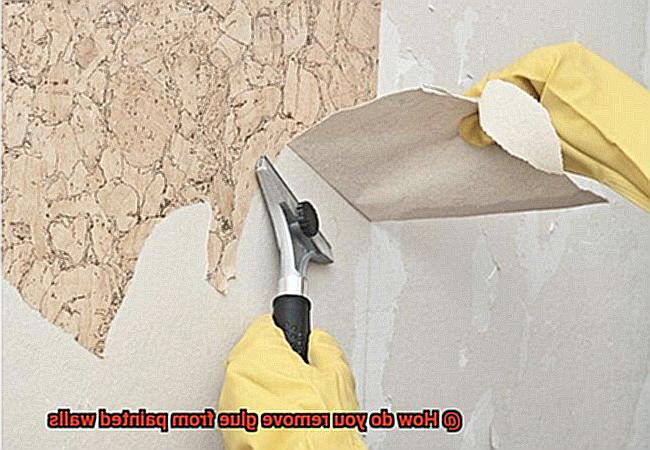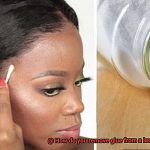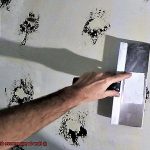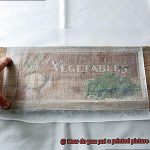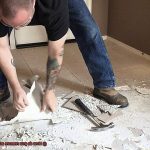Got glue stuck on your painted walls?
Don’t stress, it happens to the best of us. Whether it’s a pesky sticker residue or the aftermath of a DIY disaster, removing glue from painted walls can feel like a nightmare.
But don’t fret. In this post, we’ll walk you through a simple and effective method to restore your walls to their former glory.
So, grab your tools and let’s tackle that sticky situation together.
What Type of Glue is on the Painted Walls?
Contents
- 1 What Type of Glue is on the Painted Walls?
- 2 Warm Soapy Water Method
- 3 Vinegar Solution Method
- 4 Rubbing Alcohol Method
- 5 Heat Gun or Hair Dryer Method
- 6 Commercial Adhesive Removers
- 7 Tips for Successful Glue Removal from Painted Walls
- 8 Potential Problems with Glue Removal from Painted Walls
- 9 Conclusion
A captivating blend of adhesive glue, construction adhesive, epoxy adhesive, or silicone adhesive may grace your walls with their presence. Understanding the unique characteristics and properties of each type is essential for a successful removal journey, ensuring that your walls remain unscathed. Embark on this immersive guide where we delve into the different types of glue commonly found on painted walls, explore their pros and cons, and unveil expert tips for safe and effective removal.
Types of Glue Commonly Found on Painted Walls:
- Adhesive Glue: This water-based glue is a favorite for attaching wallpaper or other decorative materials to walls. It boasts an effortless application process and a steadfast bond. Pros: Easy application, strong bond. Cons: Not suitable for heavy objects or materials.
- Construction Adhesive: A solvent-based glue specifically designed to secure heavy objects or materials like mirrors or shelves onto walls. It offers an enduring bond but necessitates special solvents or chemicals for removal. Pros: Strong bond, durability. Cons: Removal can be quite challenging.
- Epoxy Adhesive: This adhesive steals the show with its exceptional strength and durability, making it the go-to choice for bonding a variety of materials together. Pros: Unparalleled strength, versatility. Cons: Defying removal attempts.
- Silicone Adhesive: Primarily employed for sealing purposes like filling gaps or cracks in walls, silicone adhesive flaunts flexibility and moisture resistance. Pros: Excellent sealing properties. Cons: Not intended for bonding.
Expert Tips for Glue Removal from Painted Walls:
- Warm Soapy Water: A gentle method suitable for water-based glues that will coax them away without causing damage.
- Vinegar Solution: An effective option for softening adhesive, allowing for gentle removal using a scraper or brush.
- Rubbing Alcohol: The ideal solution for stubborn glue stains; proceed with caution by first testing it on a small area to ensure it doesn’t damage the paint.
- Heat Gun or Hair Dryer: Apply heat to soften dried or hardened glue, making it easier to scrape off without harming the walls.
- Commercial Adhesive Removers: A last resort option, following product instructions and conducting a small-scale test beforehand.
Warm Soapy Water Method
The warm soapy water method is a simple yet effective technique for removing glue from painted walls. No more staring at unsightly glue stains – with this method, your walls will be spotless in no time.
To begin, gather the necessary materials: a bucket or bowl, warm water, mild dish soap, a sponge or cloth, and a scraper or putty knife. These items are essential for a successful glue removal process.
Start by diluting the mild dish soap in warm water. It’s crucial to use a mild dish soap to protect the paint on your walls. After all, nobody wants to trade a glue stain for a faded patch. Once the solution is ready, wet your sponge or cloth with it.
Now it’s time to tackle that stubborn glue. Gently scrub the glue-covered area with circular motions, applying just enough pressure to remove the glue without damaging the paint. The warm soapy water acts as a gentle yet effective solvent, loosening the adhesive.
After scrubbing, let the warm soapy water sit on the glue for a few minutes. This will soften the adhesive even further, making it easier to remove. Patience is key here.
Once the glue has had time to soften, grab your trusty scraper or putty knife. Use it to gently scrape away the softened glue from the wall. Be extra careful not to apply too much pressure, as this could damage the paint. If there are any remaining bits of glue, repeat the scrubbing and scraping process until your wall is completely glue-free.
Once all traces of glue have been successfully removed, rinse the area with clean water to remove any lingering soap residue. A thorough rinse ensures that no sticky residue is left behind.
Finally, dry the wall using a clean towel or allow it to air dry. Step back and admire your handiwork – your wall is now as good as new.
Vinegar Solution Method
The Vinegar Solution Method is a simple yet effective way to remove glue from painted walls. If you’re tired of those unsightly glue stains ruining the appearance of your walls, fear not, because this method is like a secret weapon that will effortlessly dissolve and remove that stubborn adhesive.
To begin, it’s always a good idea to test the vinegar solution on a small, inconspicuous area of the painted wall before proceeding. This step ensures that the vinegar doesn’t cause any damage or discoloration. Safety first, right?
Once you’ve given the solution the green light, it’s time to mix equal parts of white vinegar and warm water in a spray bottle or bowl. Now, take aim at that pesky glue stain and spray or apply the vinegar solution directly onto it. Let it sit for a few minutes to allow the vinegar to work its magic by penetrating and loosening the adhesive.
After a short wait, grab a clean cloth or sponge and start gently scrubbing the glue stain in circular motions. Remember not to go too hard, as we don’t want to damage the paint. Keep at it until you start to see that glue residue dissolving and lifting off from the wall surface. If necessary, reapply the vinegar solution and repeat the scrubbing process until every last trace of glue is gone.
Victory is near. Rinse off the area where you applied the vinegar solution with clean water. Pat dry with a towel and step back to admire your spotless wall.
However, there are a couple of things to keep in mind during this process. Vinegar does have a strong odor, so it’s best to open windows or use ventilation fans to help dissipate the smell. Additionally, vinegar may not be suitable for all types of paint. If you’re unsure about using vinegar on your specific painted wall, consult with a professional or test it on a small area first.
Rubbing Alcohol Method
The rubbing alcohol method is a simple and effective way to remove glue from painted walls. This household hack requires a few basic materials: rubbing alcohol, a clean cloth or sponge, a plastic scraper or putty knife, and warm water.
Before diving into the process, it’s crucial to test the rubbing alcohol on a small, inconspicuous area of the wall to ensure it won’t cause any unwanted discoloration or damage. Safety first, folks.
Once you’ve confirmed that the rubbing alcohol is safe to use, it’s time to gather your supplies and get to work. Dampen a clean cloth or sponge with rubbing alcohol and gently rub it onto the glue spot. Let the alcohol work its magic for a few minutes as it loosens up the adhesive.
Now, bring out your plastic scraper or putty knife – your trusty sidekick in this mission. Carefully scrape off the softened glue, being cautious not to apply too much pressure. Slow and steady wins the race here.
If there are stubborn remnants of glue clinging to your wall, don’t despair. Simply repeat the process by dampening the cloth or sponge with rubbing alcohol and scraping off the remaining adhesive.
Once you’ve vanquished every last bit of glue, wipe down the area with warm water to remove any residue from the rubbing alcohol. And just like that, your wall is as good as new.
Remember to always test the rubbing alcohol first and be gentle with your scraping. For more stubborn glue stains, you may need to consider using a commercial adhesive remover or seeking professional help.
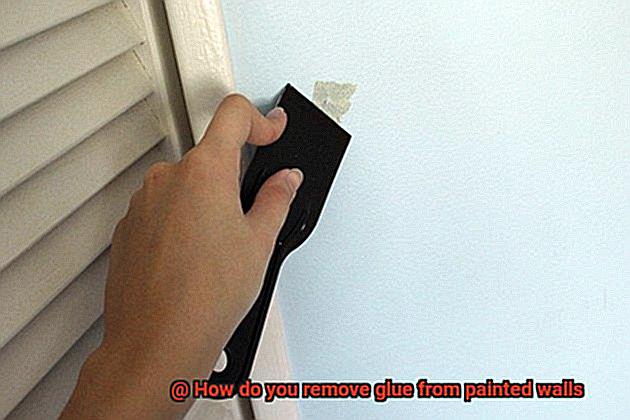
Heat Gun or Hair Dryer Method
Well, fret no more. I have just the solution for you – the heat gun or hair dryer method. This revolutionary technique will make removing glue a breeze, and I’m here to guide you through every step of the process.
First things first, let’s gather our trusty tools. Depending on your preference and what you have at hand, you’ll need either a heat gun or a hair dryer. Think of the heat gun as the superhero in this scenario, with its concentrated stream of hot air that can soften even the toughest glue. However, don’t count out the hair dryer – it may take a bit longer, but it can get the job done too.
Now, before we dive into this exciting adventure of glue removal, safety should be our top priority. Ensure that the area is well-ventilated to avoid any unpleasant fumes or odors. And remember, we’re here to remove glue, not start a fire or damage your beautiful paint job, so exercise caution and don’t overheat the glue or the wall.
Alright, let’s get down to business. Plug in your heat gun or hair dryer and set it to its lowest heat setting. Hold it about 6-8 inches away from the wall and direct that hot air towards the glue-infested area. Move the tool in a circular motion to evenly distribute the heat and prevent any hot spots from forming.
As you apply the heat, prepare to witness a magical transformation. The glue will start to soften and become more pliable under the influence of that warm air. This is your cue to grab your trusty plastic scraper or old credit card and delicately start scraping away that softened glue. Remember, gentle pressure is key here – we want to remove glue, not cause any collateral damage to your walls.
Keep heating and scraping until every last trace of glue has been vanquished from your painted walls. But what if there are some stubborn remnants left behind? Fear not. You have a couple of options. You can either repeat the process, bringing in more heat and scraping power, or you can bring out the big guns – a mild adhesive remover or rubbing alcohol can help dissolve any remaining glue.
Now that you’ve triumphed over the glue, it’s time to restore your walls’ former glory. Grab a cloth or sponge and dip it into a mixture of warm water and mild detergent. Give those walls a hearty wipe-down to remove any residue that may still be lingering. And don’t forget to dry the wall thoroughly before applying any new paint or wallpaper – we wouldn’t want any moisture to ruin your hard work.
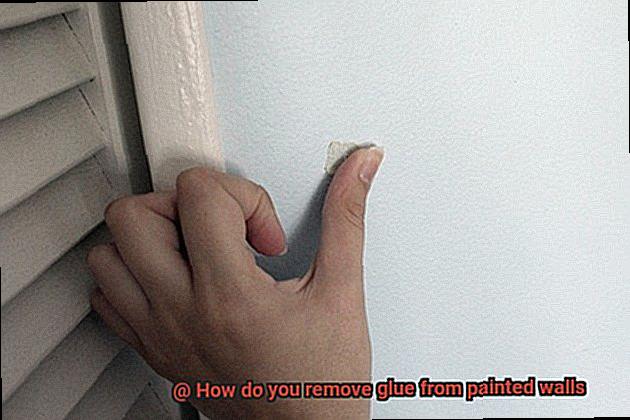
Commercial Adhesive Removers
In this comprehensive guide, we will delve into the world of commercial adhesive removers, exploring their types, advantages, disadvantages, and proper usage techniques. Bid farewell to glue troubles and restore your walls to their former glory.
Solvent-Based Adhesive Removers:
- Description: These potent removers contain chemicals like acetone or mineral spirits that dissolve glue.
- Advantages: Highly effective in breaking down adhesive bonds, making removal a breeze.
- Disadvantages: Improper use can strip paint; may emit strong odors.
- Proper Technique: Test on a small area first, apply directly onto glue, let sit for a few minutes, then scrape or wipe away softened glue.
Citrus-Based Adhesive Removers:
- Description: Made from natural ingredients like orange oil or citrus extracts.
- Advantages: Safer for painted walls; eco-friendly option; pleasant aroma.
- Disadvantages: May be less effective on strong adhesives.
- Proper Technique: Same as solvent-based removers.
Heat Gun or Hair Dryer Method:
- Description: Utilizing hot air to soften glue before scraping it away.
- Advantages: Effective against even the toughest glues; no additional chemicals required.
- Disadvantages: Requires caution to avoid surface damage; unsuitable for delicate paint.
- Proper Technique: Apply heat to the glue using a heat gun or hair dryer, then gently scrape away softened glue.
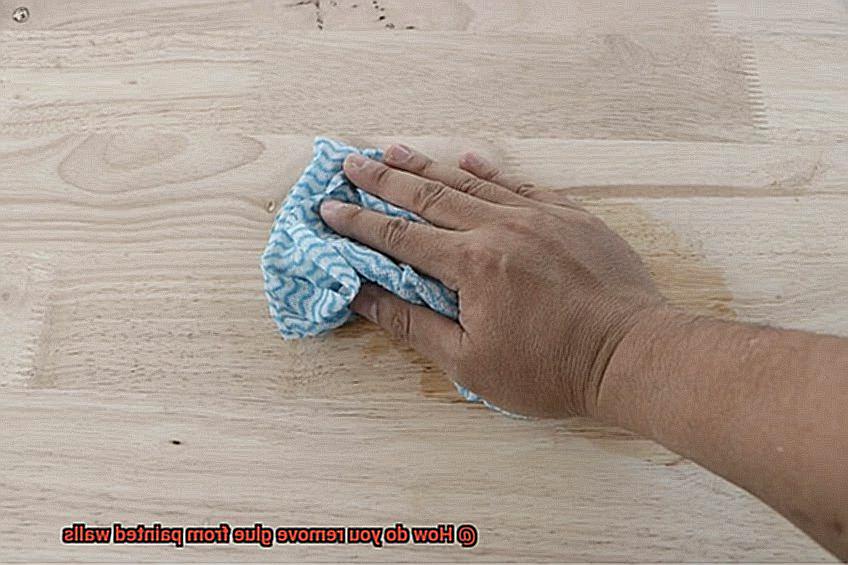
Tips for Successful Glue Removal from Painted Walls
We’ve got you covered with these tips and tricks for successful glue removal. With the right techniques and tools, you can restore your walls to their former glory in no time.
Identify the Type of Glue
Start by identifying the type of glue that is on your painted walls. Different glues require different removal methods. Whether it’s adhesive tape residue, craft glue, super glue, or construction adhesive, knowing what you’re dealing with will guide your removal process.
Protect the Surrounding Area
Before you begin removing the glue, take precautions to protect the surrounding area. Cover the floor and any furniture or fixtures near the wall with drop cloths or plastic sheets. This will prevent any damage or staining during the removal process. Safety first.
Use Heat
One effective method for removing glue from painted walls is to use heat. Grab a hairdryer or heat gun on a low setting and hold it a few inches away from the glue. Move it in a circular motion to soften the glue and make it easier to scrape off. A plastic scraper or putty knife will come in handy for this step.
Try Commercial Adhesive Removers
If heat doesn’t do the trick, don’t worry. There are commercial adhesive removers available that are specifically designed to dissolve adhesives without damaging the paint. Be sure to follow the instructions carefully and test it on a small area before applying it to the entire glue stain.
Combination of Methods
For stubborn or dried glue stains, you may need to use a combination of methods. Start by scraping off as much of the glue as possible with a plastic scraper or putty knife. Then, apply a small amount of adhesive remover or rubbing alcohol to a clean cloth and gently rub the remaining glue until it comes off.
Remember to always test any method or product on a small, inconspicuous area of the wall before proceeding with the entire surface. After successfully removing the glue, give your wall a thorough cleaning with warm soapy water and a soft cloth to remove any residue. Rinse with clean water and dry with a towel.
In the unfortunate event that the glue cannot be removed without damaging the paint, it may be necessary to repaint the affected area. Consult with a professional painter or home improvement expert for guidance on how to properly repaint the wall.
To avoid future glue stains on painted walls, take preventative measures when working with glue or adhesive products. Use drop cloths or protective sheets and be careful not to spill or drip any glue onto the walls.
Potential Problems with Glue Removal from Painted Walls
Fear not. In this article, we’ll delve into the potential problems and safety hazards associated with removing glue from painted walls, equipping you with expert tips and tricks to make the process a breeze.
Problem 1: Damaging the Paint
One of the most common hurdles when removing glue from painted walls is the risk of damaging the paint. The adhesive can form an unbreakable bond with the paint, leading to peeling, chipping, or unsightly discoloration. To sidestep this challenge, consider using gentle removal techniques such as applying heat or employing a commercial adhesive remover specially formulated for painted surfaces.
Problem 2: Sticky Residue
Even after successfully removing the glue, an unwelcome residue may linger behind. This sticky residue acts like a magnet for dirt and dust, making your wall appear perpetually grubby. Combat this issue by utilizing a mild detergent solution or a mixture of warm water and vinegar to thoroughly cleanse the affected area.
Problem 3: Stubborn Adhesives
Certain glues, such as epoxy or construction adhesive, possess an uncanny ability to resist removal efforts. These formidable foes demand more aggressive techniques or specialized products designed specifically for these stubborn adhesives.
Problem 4: Avoiding Further Damage
Beware. Attempting to remove glue from a painted wall without employing proper techniques or harsh chemical solvents can exacerbate the situation. It is crucial to approach glue removal with caution, utilizing appropriate methods and products to prevent additional harm to the paint or underlying surface.
Problem 5: Time and Effort
Glue removal can be a time-consuming and labor-intensive task. Depending on the quantity and type of glue, it may require multiple attempts and considerable elbow grease. Patience is key, so allocate enough time to tackle the task at hand.
Safety Hazards:
Finally, let’s not forget about safety. Some adhesive removers or solvents contain potent chemicals that can be harmful if not handled with care. Always prioritize safety by wearing protective gloves and ensuring proper ventilation when using these products.
0yUQD_QY11Y” >
Also Read: How To Remove Adhesive From Wall Without Damaging Paint
Conclusion
Removing glue from painted walls can be a daunting task, but with the right techniques and a little patience, you can restore your walls to their former glory.
One method is to start by gently scraping off any excess glue using a plastic scraper or credit card. Be careful not to damage the paint in the process.
Next, apply a generous amount of warm soapy water to the affected area and let it sit for a few minutes. This will help soften the glue and make it easier to remove.
Then, using a clean cloth or sponge, gently scrub the glue in circular motions until it starts to loosen. Rinse the area with clean water and repeat if necessary.
For stubborn glue stains, you may need to use a specialized adhesive remover or rubbing alcohol. Just remember to test these products on an inconspicuous area first to ensure they don’t damage the paint.
Finally, once all the glue is removed, give your walls a thorough cleaning with mild detergent and water to remove any residue.

